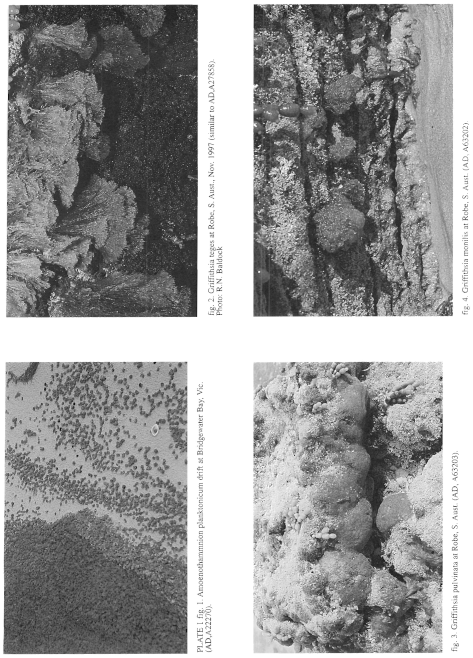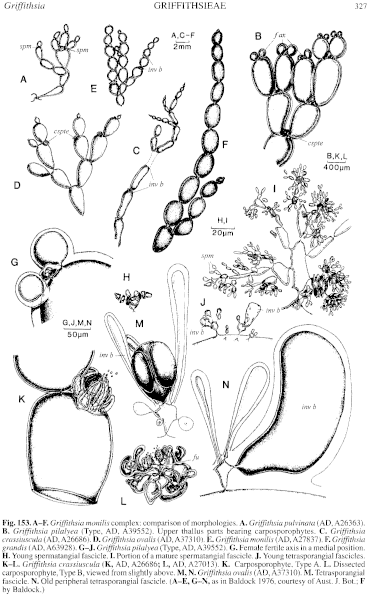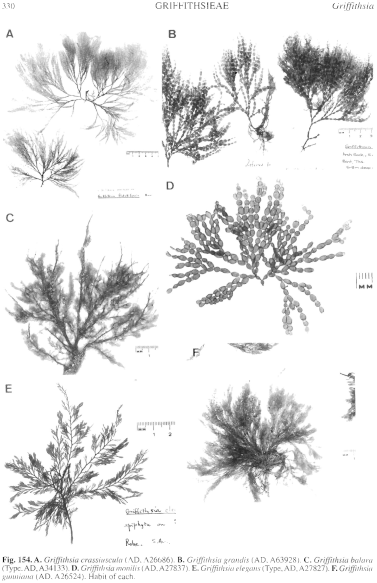|
|
|
|
|
|||||||||||
|
Electronic Flora of South Australia Species Fact Sheet
Phylum Rhodophyta – Order Ceramiales – Family Ceramiaceae – Tribe Griffithsieae
Selected citations: J. Agardh 1876: 65. Baldock 1976: 517, figs 1–7, 75. De Toni 1903: 1283. Guiler 1952: 95. Huisman & Walker 1990: 423. Lucas 1909: 48; 1929a: 24; 1929b: 53. Lucas & Perrin 1947: 326. Millar & Kraft 1993: 40. Sonder 1881: 11. Tisdall 1898: 502. Wilson 1892: 186. Womersley 1950: 177.
Thallus (Fig. 154D) dark red, 1.5–4.5 (–8) cm high, branching spreading, several times subdichotomous, ecorticate, distinctly moniliform throughout. Attached by filamentous rhizoids from cells at the thallus base; epilithic or epiphytic. Structure. Cells prolonged at their bases into a short neck (Fig. 155C), near the thallus apex globose, 0.5–2 mm in diameter, in mid thallus globose to ovoid, 1.6–2.5 mm and L/D 1–1.3, basal thallus cells ovoid, rarely cylindrical. Filaments strongly constricted between cells, attenuate towards the apices (Fig. 153E).
Reproduction: Gametophytes dioecious. Female axes subapical, of 3 small, discoid cells, displaced laterally or into an apparently terminal position by the continued growth of the vegetative axis, sometimes arising in opposite pairs on the same vegetative cell, flanked by caducous, hair-like synchronic laterals (Fig. 155A); procarp systems (Fig. 155D) subapical, each with a sterile lateral cell and a supporting cell bearing a sterile cell apically and 1–2 recurved carpogonial branches of 4 cells laterally; hypogenous cell (Fig. 155B) producing abaxially 2-celled synchronic involucral branches with swollen terminal cells (Fig. 155C); post-fertilisation fusion cell columnar, bearing 1–3 gonimolobes terminally, most cells of which form globose-ovoid carposporangia, 27–45 µm in diameter. Spermatangia borne on whorls of numerous, minute, fascicles from the upper shoulders of vegetative cells near the thallus apex, clustered in the constrictions between cells, each fascicle initially a pedicel bearing 5 polychotomous branches (Fig. 155E) developing 2–8 further terete axial cells (Fig. 155F) each bearing whorls of 5 polychotomous clusters producing spermatia terminally; involucral cells absent, or present in var. cincta.
Tetrasporangia produced successively in clusters of 2–12 on whorls of numerous, minute, fascicles in similar positions to the spermatangial masses, globose or lachrimiform, 50–80 µm in diameter, tetrahedrally divided; fascicles internal to a cluster (Fig. 155G) consisting of single terete pedicels, those peripheral to a cluster (Fig. 155H) developing 1–3 further small axial cells, the basal cell displaced into a recumbent position by the production of a swollen reniform involucral cell, often apically furcate, 210–410 µm long and 130–180 µm in diameter.
Lectotype: (Baldock 1976, p. 517) from "Swan River" (Harvey, Alg. Aust. Exsicc. 495A); in Herb. Harvey, TCD; isotype in MEL, 684, epiphytic on "Zostera" (Posidonia).
Distribution: Rottnest I. and Fremantle, W. Aust., to Tasmania (Sonder 1881, p.11) and N.S.W. (Millar & Kraft 1993, p. 40).
Taxonomic notes: G. monilis is found in the lower eulittoral to 5m deep, and morphological variations occur with depth and degree of wave action which may make separation from G. ovalis and G. grandis difficult unless tetrasporangial plants are available.
Two varieties of G. monilis can be differentiated on reproductive features.
References:
AGARDH, J.G. (1876). Species Genera et Ordines Algarum. Vol. 3, Part 1- Epicrisis systematic Floridearum, pp. i-vii, 1–724. (Weigel: Leipzig.)
BALDOCK, R.N. (1976). The Griffithsieae group of the Ceramiaceae (Rhodophyta) and its southern Australian representatives. Aust. J. Bot. 24, 509–593.
DE TONI, G.B. (1903). Sylloge Algarum omnium hucusque Cognitarum. Vol. 4. Florideae. Sect. 3, pp. 775–1521 + 1523–1525. (Padua.)
GUILER, E.R. (1952). The marine algae of Tasmania. Checklist with localities. Pap. Proc. R. Soc. Tasmania 86, 71–106.
HARVEY, W.H. (1855a). Some account of the marine botany of the colony of Western Australia. Trans. R. Jr. Acad. 22, 525–566.
HARVEY, W.H. (1859b). Algae. In Hooker, J.D., The Botany of the Antarctic Voyage. III. Flora Tasmaniae. Vol. II, pp. 282–343, Plates 185–196. (Reeve: London.)
HARVEY, W.H. (1863). Phycologia Australica. Vol. 5, Plates 241–300, synop., pp. i-lxxiii. (Reeve: London.)
HUISMAN, J.M. & WALKER, D.I. (1990). A catalogue of the marine plants of Rottnest Island, Western Australia, with notes on their distribution and biogeography. Kingia 1, 349–459.
LUCAS, A.H.S. & PERRIN, F. (1947). The Seaweeds of South Australia. Part 2. The Red Seaweeds. (Govt Printer: Adelaide.)
LUCAS, A.H.S. (1909). Revised list of the Fucoideae and Florideae of Australia. Proc. Linn. Soc. N.S.W. 34, 9–60.
LUCAS, A.H.S. (1929a). The marine algae of Tasmania. Pap. Proc. R. Soc. Tasm. 1928, 6–27.
LUCAS, A.H.S. (1929b). A census of the marine algae of South Australia. Trans. R. Soc. S. Aust. 53, 45–53.
MILLAR, A.J.K. & KRAFT, G.T. (1993). Catalogue of marine and freshwater Red Algae (Rhodophyta) of New South Wales, including Lord Howe Island, South-western Pacific. Aust. Syst. Bot. 6, 1–90.
SONDER, O.W. (1881). In Mueller, F., Fragmenta Phytographiae Australiae. Supplementum ad volumen undecinum: Algae Australianae hactenus cognitae, pp. 1–42, 105–107. (Melbourne.)
TISDALL, H.T. (1898). The algae of Victoria. Rep. 7th Meet. Aust. Ass. Adv. Sci., Sydney, 1898, pp. 493–516.
WILSON, J.B. (1892). Catalogue of algae collected at or near Port Phillip Heads and Western Port. Proc. R. Soc. Vict. 4, 157–190.
WOMERSLEY, H.B.S. (1950). The marine algae of Kangaroo Island. III. List of Species 1. Trans. R. Soc. S. Aust. 73, 137–197.
The Marine Benthic Flora of Southern Australia Part IIIC complete list of references.
Publication:
Womersley, H.B.S. (24 December, 1998)
The Marine Benthic Flora of Southern Australia
Rhodophyta. Part IIIC. Ceramiales – Ceramiaceae, Dasyaceae
©State Herbarium of South Australia, Government of South Australia
Illustrations in Womersley Part IIIA, 1998: PLATE 1 fig. 4; FIGS 153E, 154D, 155 A–H.

Plate 1 enlarge
PLATE 1 fig. 1. Amoenothamnion planktonium drift at Bridgewater Bay, Vic. (AD, A22270).
fig. 2. Griffithsia teges at Robe, S. Aust., Nov. 1997 (similar to Ad, A27858). Photo: R.N. Baldock.
fig. 3. Griffithsia pulvinata at Robe, S. Aust. (AD, A63203).
fig. 4. Griffithsia monilis at Robe, S. Aust. (AD, A63202)

Figure 153 enlarge
Fig. 153. A–F. Griffithsia monilis complex: comparison of morphologies. A. Griffithsia pulvinata (AD, A26363). B. Griffithsia pilalyea (Type, AD, A39552). Upper thallus parts bearing carposporophytes. C. Griffithsia crassiuscula (AD, A26686). D. Griffithsia ovalis (AD, A3731.0). E. Griffithsia monilis (AD, A27837). F. Griffithsia grandis (AD, A63928). G–J. Griffithsia pilalyea (Type, AD, A39552). G. Female fertile axis in a medial position. H. Young spermatangial fascicle. I. Portion of a mature spermatangial fascicle. J. Young tetrasporangial fascicles. K–L. Griffithsia crassiuscula (K, AD, A26686; L, AD, A27013). K. Carposporophyte, Type A. L. Dissected carposporophyte, Type B, viewed from slightly above. M, N. Griffithsia ovalis (AD, A37310). M. Tetrasporangial fascicle. N. Old peripheral tetrasporangial fascicle. (A–E, G–N, as in Baldock 1976, courtesy of Aust. J. Bot.; F by Baldock.)

Figure 154 enlarge
Fig. 154. A. Griffithsia crassiuscula (AD, A26686). B. Griffithsia grandis (AD, A63928). C. Griffithsia balara (Type, AD, A34133). D. Griffithsia monilis (AD, A27837). E. Griffithsia elegans (Type, AD, A27827). F. Griffithsia gunniana (AD, A26524). Habit of each.

Figure 155 enlarge
Fig. 155. A–C. Griffithsia monilis var. monilis (AD, A26385). A. Procarp at fertilization. B. Procarp soon after fertilization. C. Young carposporophyte. D–H Griffithsia monilis var. cincta (AD, A63201). D. Fertile axis with a single supporting cell bearing 2 carpogonial branches. E. Young spermatangial fascicle. F. Peripheral spermatangial fascicle. G. Inner tetrasporangial fascicle. H. Peripheral tetrasporangial fascicle. I. Griffithsia grandis (AD, A63928). Types of tetrasporangial fascicle. (A–H, as in Baldock 1976, courtesy of Aust. J. Bot.; I by Baldock.)

|
Email Contact: State Herbarium of South Australia |

|